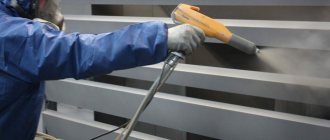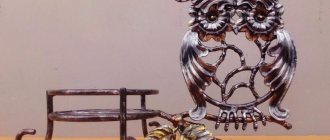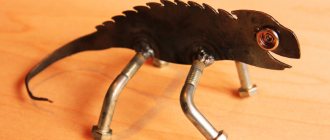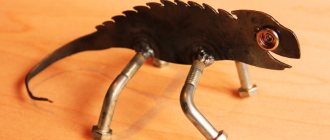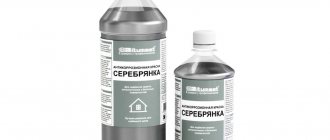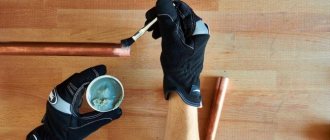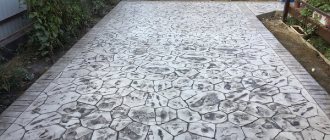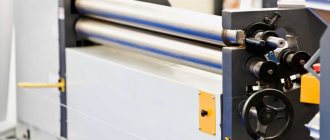Painting is a popular way to change the color of metal. To obtain the desired result, it is important to strictly follow the technology and select the paint, taking into account the operating conditions of the enamel. Painting metal allows you to change the design of the surface, protect the material from the destructive effects of moisture and the formation of rust.
Painting metal surfaces
The essence and features of the method
Painting of metal products was initially used to change color and give surfaces an interesting shade, but simple enamel quickly cracked and rust appeared underneath. Therefore, manufacturers began to develop new types of coloring compounds that could protect the metal from corrosion.
On sale you can find different types of paint that is suitable for metal surfaces. It can be applied in different ways. In this case, hand tools and industrial equipment are used.
What are blacksmith paints
Recently, forging paints, specially optimized for working with forged materials, have become very popular. Such paints are applied to forging for decorative purposes, which makes it possible to imitate a wide variety of surfaces, from gold to cast iron.
The cost of such paints is higher than that of ordinary ones. However, this is due to their increased shelf life, which reaches 5 years or more. At the same time, such paints also look really impressive, allowing you to give the required visual effect by the very fact of their presence. Without the need for different painting methods.
Today there are many types of such coating, but the most popular is the German WS-Plast paint, produced by Weigel & Schmidt GmbH. These paints allow you to give metal surfaces a variety of different colors and textures. Here you will find emerald color, graphite with red tones, and various types of antique painting. Moreover, such a coating not only decorates, but also protects the metal surface from corrosion and other troubles caused by the influence of nature.
Also popular is hammer paint (Hammerite), which is currently becoming more and more in demand. The reason is that such paint does not require the application of a primer, and can even be used directly on surfaces damaged by corrosive processes. However, if the rust is loose, it will still have to be removed. The surface treated with this coating becomes monochromatic with the effect of unevenly shaped patterns and aluminum flakes.
The application of this paint is mainly practiced on ferrous metals such as steel and cast iron. However, it can also process some non-ferrous metals.
Is it possible to paint metal?
Metal structures are often made of black iron. Since this material oxidizes very quickly, it must be protected from moisture and rust. For this purpose, special anti-corrosion compounds or metal paint can be used.
Galvanized metals, thanks to a layer of zinc and chromium, are already protected from rust. The protective layer retains its integrity for up to 15 years. If you want to increase this figure, the surfaces can be additionally painted.
Painted disc
Application methods
To apply paint you can use:
- Paint brush. Suitable for painting small parts. You can find brushes of different sizes on sale. The bristles can be natural or synthetic. For access to hard-to-reach places, the tool is equipped with an elongated curved handle.
- Roller. Suitable for painting large flat surfaces.
- Sprayers. The second name for the spray gun. A compressor is used to operate them. The coloring composition is supplied under pressure. The equipment is used by large enterprises, car repair shops, carpentry, and blacksmith shops.
- Containers for dipping metal workpieces. This method makes it easy to paint parts with complex shapes.
Modern technology - powder coating of metal. The blanks are placed in a closed spray booth and covered with a layer of paint. Its particles receive a negative electrical charge and are attracted to the working surface, creating a dense, uniform layer. After applying the powder, the workpiece is placed in an oven so that the decorative layer bakes and becomes monolithic.
Paint brush
Antique painting
One of the most popular ways to paint black metal is the antique effect. In this case, several coating options are applied to the metal surface in a certain order. But first, the metal itself must be properly prepared. It must be cleaned of corrosion, sanded, and dirt and grease are removed. Only when you are confident that the surface is clean can you begin the process, which is divided into several stages:
- Using a brush, apply metallic paint to the surface. Don't be afraid to do it casually, as this will only help with the effect we are creating;
- Once the first layer has completely dried, it is necessary to apply a craquelure primer. The latter allows you to obtain a layer of transparent film created from polymers;
- The craquelure coating is applied after the primer layer has dried, which allows you to get characteristic cracks, similar to those that appear on things that have been used for decades and even centuries.
Important! Instead of a craquelure composition, the effect of antiquity can be achieved by applying burnt umber to the paint. In this case, it is best to work with a dry cloth, and remove the residue after the paint layer has dried.
Types of coloring compositions
Varieties:
- Oily. Suitable for decorative finishing of surfaces indoors and outdoors. Made from organic substances. Before applying oil paint, you need to cover the working surface with primer. The main disadvantage is the persistent pungent odor. Such enamels can only be used in ventilated areas.
- Epoxy. Manufactured on the basis of silicone resin. In order for the composition to set, different hardeners are used. Can only be used for exterior painting as they are highly toxic. It is difficult to work with epoxy paints, but the finished coating reliably protects surfaces from rust.
- Acrylic. The basis of such paints are polymers. Suitable for painting metal parts indoors.
- Alkyd. Used for external and internal work. Easy to apply, no primer required.
- Rubber. Special dyes used to coat the external sides of building walls and roofs. Withstands prolonged exposure to moisture and ultraviolet radiation.
For metal, you need to choose paints that protect against rust. Before painting, the surfaces must be coated with a primer containing a high zinc content.
How to calculate paint consumption?
The paint consumption for metal can be found on the container. It is indicated on the back of the label or front side. If for some reason there is no designation, you need to know that 1 liter is enough for about 14 m2.
Consumption depends on the application method, the presence of complex elements, surface structure, and type of paint.
Advantages and disadvantages of the method
The pros and cons of painting metal depend on the type of paint composition used. Advantages of painting metal surfaces, provided the technology is followed:
- Getting the required shade. You can find different colors on sale.
- Availability of consumables.
- Easy to apply paint using a brush or roller.
- Protection against rust formation.
Flaws:
- Many types of coloring compounds emit a persistent, unpleasant odor. The room needs to be ventilated for a long time.
- For powder coating you will need special equipment, a spray booth.
- Not all types of paint protect metal from corrosion.
Most of the shortcomings can be leveled out if you buy a high-quality coloring composition and carry out the work strictly following the technology.
Under what conditions can metals be painted without stripping?
Preparing a metal element for painting consists of stripping, sanding, priming twice and applying a protective paint layer for finishing. But it is not always possible to clean metal surfaces, for various reasons - cramped conditions, inaccessibility of the element, etc. In some cases, it is possible, and much easier, to use special coatings. But the presence of these special paints and varnishes, of course, does not mean that you can do without any preparation for painting. This is not true for several reasons.
Firstly, the loose rusty layer of the surface has accumulated moisture, air and possibly substances that can activate corrosion even without access to oxygen and water. In this case, oxidation reactions will continue under a layer of any paint, and it is unknown how this will affect the paint layer - the operating conditions of the paintwork will be too extreme.
Secondly, the surface of the element being painted may have different quality characteristics. If the rust has formed in a uniform layer of thin thickness, like a powder coating, then the paint will be able to adhere to the base metal, penetrating the rusty layer, and there will be adhesion.
In this case, the painted layer will be durable and rusting will either slow down very much or stop completely. But if the rusty layer swells, the rust begins to flake off, then any paint, even special paint, will come off from such a surface. Peeling of the paint layer is also guaranteed if there is an oil layer on the metal (for example, the rolled profile has not been degreased). If oil impurities are residual on the surface, then the behavior of the paint coating is difficult to predict.
About preparing the surface for painting
All metal structures require surface preparation for painting, at least to a minimum. Preparation methods depend on the condition of these surfaces:
- If rust appears in the form of small spots or a uniform thin layer, then preparation consists of degreasing and dust removal. Wipe metal surfaces with a rag and generously moisten them with solvents. Degreasing products in aerosol packages that contain corrosion inhibitors (inhibitors) have a good effect, reducing the chemical activity under the paint coating to zero.
- In cases where the surface is heavily rusted, it is cleaned manually using a scraper. The flaking rust is peeled off and then treated with metal brushes. Cleaning to a metallic shine is not necessary; a layer of rust may remain if it is dense, strong and adherent to the metal surface, and preferably even.
Complete drying of the metal surface before painting is a prerequisite. If possible, the products are kept under a roof in conditions close to normal - humidity up to 45% and temperature 18 - 30⁰C. In order to paint stationary structures with the highest quality in atmospheric conditions, painting is timed to occur in warm sunny weather, at least three days before painting. It is important that moisture evaporates from the rust layers as much as possible, this will significantly reduce the risk of rapid damage to paint coatings.
Primer
It is possible to apply paint without first removing rusty layers in several ways, but basic technologies are only possible in a factory environment. Heavy metal structures undergo special protective treatment before being sent to the construction site. For private construction, two methods are possible:
- Passivation of the surface with compounds containing orthophosphoric acid, and then coating with two-component paints. These paints are considered expensive, but their use has an effect. The layer with which the two-component composition is applied is thicker and forms a durable film. Such a film makes even minimal gas exchange impossible; oxygen and water vapor do not get under the coating. In addition, two-component paints have elasticity with a high hardness of the coating, and swelling of rust is limited, its layer is compacted and further oxidation reactions on the surface under the paint layer are slowed down to zero.
- Applying a layer of universal primer, provided the composition is suitable for coating against rust, and subsequent painting with alkyd or polyurethane enamels. This method is considered budgetary. Primer and enamel will protect the structure for about two to three years, after which the coating will need to be renewed. The enamel layers are degreased and cleaned again, and the next layer is applied on top. Over time, the total thickness of the coating will be sufficient to ensure complete isolation of the structure from the atmospheric environment.
Coloring at home
If necessary, metal products can be painted yourself. To do this, you need to choose a method for applying enamel, prepare the required tools and surfaces, and apply the composition.
Tools and equipment
For the classic method of painting metal, you need to prepare:
- roller, brushes of different widths;
- paint container;
- the coloring composition must be shaded;
- primer for metal.
Additionally, you will need masking tape and plastic film.
Surface preparation
Do not apply paint to unprepared surfaces. Before starting work, you need to perform several steps:
- Clean the metal from dirt and rust. To do this, you can use a grinder, grinder, metal brush or acid.
- Degrease surfaces with solvent.
- Putty the uneven areas.
After the preparatory work, you can apply a primer.
Preparation of material
Application of the composition
Surfaces that do not need to be painted should be covered with plastic film. The edges must be covered with masking tape. Painting with a brush is easy. It needs to be dipped 1/3 of the way. The number of layers depends on the desired result.
Do-it-yourself painting of metal products - surface preparation
The result you get also depends on how correctly you prepared the surface of the product. First of all, it is necessary to clean the structure of any debris, deposits, old layers of paint and varnish. Scrapers are usually used for work, but you can use sandpaper or a metal sponge.
Stains of salt, oil and fat - everything must be washed off. It's best to use non-abrasive cleaners, even a soap and water solution. After this, be sure to rinse the surface with clean water and let it dry.
If you have to work with a very large product, you can use an acid-acetylene torch. As a result, the paint will burn and the rust layer will fall off.
If you cannot remove the rust, you can use a converter. This is a mixture prepared on the basis of phosphoric acid. The affected part of the structure is covered with the mixture and left for more than 3 hours. After this, you need to rinse everything off with water and dry it.
Recommendations and safety precautions
Safety regulations:
- The room in which the work will take place must be well ventilated.
- If the solvent is spilled, the resulting stain must be covered with sand.
- You should work in a respirator, safety glasses, gloves, and long-sleeved overalls.
- The remaining paint must be poured into a separate container and sealed tightly.
- Used jars should be washed or thrown away.
Do not pour any remaining paint down the drain.
Metal painting is performed to change the shade of the product and protect the material from rust. To obtain the desired result, you need to choose one of the possible methods of applying the coloring composition and select the paint. Attention should also be paid to the preparation of metal surfaces. Without it, the decorative coating will be destroyed in a short period of time.
